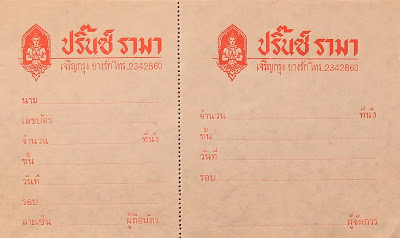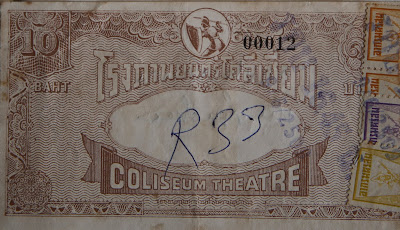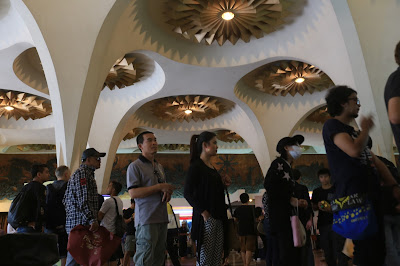Endangered species
It's perplexing to think that one of Thailand's most endangered buildings is also one of its most beloved, but such is the dual status held by Bangkok's Scala Theatre - Thailand's last operating movie palace.
The Scala Theatre; little altered since its grand opening in 1969.
Scala's trademark vaulted ceiling and 5-tiered glass orb chandelier.
Since its grand opening on New Years Eve, 1969, The Scala Theater - referred to locally simply as "Scala" - has provided a world-class cinema experience to anybody with a couple hours and a bit of Baht to spare. It's also arguably
the most architecturally grand movie theater left in all of Southeast Asia, a fact not lost on Thailand’s conservation community. In 2012, the Association of Siamese
Architects (Under Royal Patronage) certified the Scala an architecturally
significant structure, giving the parent company, Apex, an award for preservation.
The theater's sumptuous modern lobby, featuring a
5-tiered frosted glass chandelier, tapered columns, golden star ceiling
medallions and a 10-plus meter horizontal wall relief are some of the
highlights of this a one-of-a-kind architectural spectacle. Scala's splendor has helped cement its status not just as a cinephiles' paradise and architectural spectacle, but as a leading Bangkok event space in general. In an area of the city now teaming with glitzy shopping malls, the Scala is a pritine hold out from Thailand's golden age of movie theaters.
Scala's fate rests in the hands of the Property Management Office of Chulalongkorn Univerity - landlord of the theater and surrounding Siam Square neighborhood. In 2012, Chulalongkorn announced plans which called for the demolition of Scala, its less-ornate sister theater, Lido, and the surrounding three-story shop-house community that comprises the neighborhood. The cleared land would be used to build a series of shopping malls, aimed at driving up revenue for the university.
Immediately following that initial announcement, a chorus opposition erupted across the Thai media, citing Scala's unique architectural merits and its distinction as the last operating stand-alone movie theater in a city once packed with them. In mid-2016, a Chang.org petition was circulated on-line entitled "Keep Scala" and calling for the theater to be awarded heritage status. It's this level of endearment that the Scala commands.
Sustained public pressure combined with less than ideal economic circumstances has led officials at Chulalongkorn University to respond with a series of lease extensions to the Apex Co.. Otherwise there are no guarantees
Scala's lease expires in 2019.
How to get off the endangered species list
At a quarter of noon on October 15th, The Scala Theater's airy bi-level lobby rang with the din of a large, avid crowd. The assembled mass consisted almost exclusively of Bangkok cinema enthusiasts, casually mingling in anticipation of a one-off screening of "The Good, The Bad and The Ugly," part of a year-long World Class Film series presentation at Scala by the Thai Film Archive.
At noon, the vestibule doors parted and the crowd streamed into the grand auditorium, settling in for the three hour ride through Sergio Leone's Spaghetti Western epic.
As the lights began to dim, the one-thousand seat auditorium appeared to be at about 70% capacity, with the only large swaths of empty seats located in the first few rows closest to the screen. While the opening credits flashed overhead, a dozen or so stragglers scurried to their seats.
On a typical day at the Scala, filling ten-percent of the seats is a struggle. That's not for a lack of devotees to the iconic movie palace. There are plenty of them. The problem is that on most days there are anywhere from 10 to 50 other screens, all located in multiplex theaters across the metropolis, showing the same mainstream movie. Finding enough of a market share to fill 20% of the seats - the break-even point for most movie theaters - is untenable at that rate. Add to the mix the growing use of streaming services like Netflix cutting into theater attendance and the Scala's prospects for profitability seem slim to nil.
But this is where the Thai Film Archive has tapped into something big.
Scala is a movie lovers' movie theater. The kind of place that genuine cinephiles flock to as much for the no-gimmicks movie-watching experience as for the sumptuous atmosphere. Unlike the rest of Bangkok's silver screen, Scala is a stand-alone theater, meaning there's no soulless shopping mall to navigate before you reach the box office. That, in turn, keeps the cinephiles coming out.
There are different degrees of Scala regulars. From die-hards who watch every movie that comes through, to the casual movie fans who are fond of Scala for the cultural capital it brings to Bnagkok, but could take it or leave it as far as a place to watch movies goes.
The common thread tying all Scala fans together, however, is that when a unique film is showing there, they will come out in droves. Case in point, Clint Eastwood blasting away along side Lee Van Cleef and Eli Wallach in The Good, The Bad and The Ugly.
It's no coincidence that the Film Archive has been increasing its programming presence at Scala in recent years. In the face of mounting pressure from the landlord to knock the building down, the Film Archive has shown on multiple occasions that the Scala still has the power to pack 'em in.
The key is unique programming. Besides the vintage films programmed by the Film Archive from time to time, I've seen Scala mobbed whenever a highly anticipated film gets first run there, even if it's screening elsewhere in the city.
Like other stand-alone cinema halls that have been readapted to fit contemporary tastes, the Scala exudes class, and would do well if it were programmed thoughtfully like others of its kind. Imagine if Scala were to become the Thai equivalent to
San Francisco's Castro Theater, screening double and triple features of classic films on a daily basis. Again, there's no shortage of cinephiles in Bangkok. They're just not being catered to. Do this with the Scala and Bangkok will have a bona fide cinema institution.
A cinephile's delight: The Good, The Bad and The Ugly at the Scala
The difficulty moving forward will be convincing a revenue-hungry university that Scala matters.


























































